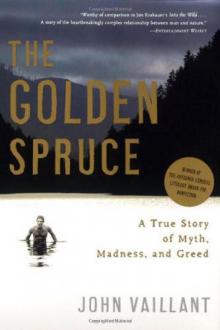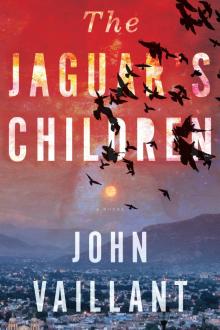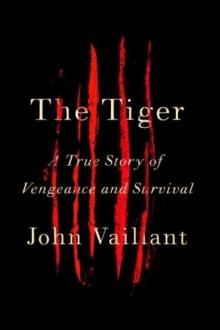- Home
- John Vaillant
The Golden Spruce: A True Story of Myth, Madness, and Greed
The Golden Spruce: A True Story of Myth, Madness, and Greed Read online
CONTENTS
TITLE PAGE
DEDICATION
MAP
ACKNOWLEDGMENTS
EPIGRAPH
Prologue Driftwood
1 A Threshold Between Worlds
2 The Beginning of the End
3 A Boardwalk to Mars
4 The People
5 Wildest of the Wild
6 The Tooth of the Human Race
7 The Fatal Flaw
8 The Fall
Photo Insert
9 Myth
10 Hecate Strait
11 The Search
12 The Secret
13 Coyote
14 Over the Horizon
Epilogue Revival
WOOD MEASUREMENT
BIBLIOGRAPHY
ENDNOTES
PHOTO CREDITS
PRAISE FOR THE GOLDEN SPRUCE
COPYRIGHT
for Nora
All Trees of noblest kind for sight, smell, taste;
And all amid them stood the Tree of Life,
High eminent, blooming Ambrosial Fruit
Of vegetable Gold; and next to Life
Our Death the Tree of Knowledge grew fast by,
Knowledge of good bought dear by knowing ill.
—John Milton, PARADISE LOST
ACKNOWLEDGMENTS
THIS BOOK WOULD NOT exist if not for hundreds of acts of generosity on the part of individuals who freely shared the fruits of their hard won knowledge and experience. I wish to express my particular gratitude to the Tsiij git’anee clan, especially Chief Donald Bell, Dorothy Bell, Lucille Bell, Robin Brown, and Leo Gagnon, for granting me permission to write about the story of the golden spruce. I am equally grateful to Cora Gray, and to those members of the Hadwin family who shared their memories and insights with me. I would also like to thank Guujaaw, the current President of the Council of the Haida Nation, for taking the time to speak with me on numerous occasions. Thanks, also, to Caroline Abrahams, Marilyn Baldwin, Perry Boyle, John Broadhead, Diane Brown, Neil Carey, Frank and Nika Collison, the late Ernie Collison, Betty Dalzell, Kiku Dhanwant and Gerry Morigeau, Bart DeFreitas and Carolynter Borg, Tom and Astrid Greene, Paul Harris-Jones, Marina Jones, Judy Kardosh, Ian Lordon, Bruce Macdonald, Nathalie Macfarlane, Neil McKay, Jack Miller, Irene Mills, Alex Palmer, Wesley Pearson, David Phillips, Dave Rennie, Raven Rorick, Hazel Simeon, Bill Stevens, Harry Tingley, Al and Gladys Vandal, Scott Walker, Al Wanderer, Ernie Wilson, Jennifer Wilson, and Elois Yaxley for sharing their thoughts, recollections, and excellent advice. Thanks to Archie Stocker for his video footage and photos, and to Todd Merrell, whose excellent documentary enhanced my understanding of the Haida worldview. I would also like to thank Steve Petrovcic for sharing his painstaking research, the Reverend Peter Hamel for permission to reprint his fine sermon, and the staff at the Observer and the Daily News, for their assistance with research.
Several people in the UBC Forestry Department were very helpful including John Worrall, Suzanne Simard, and Dennis Bendickson, who fielded a random phone call and connected me to Bill Weber, whose willingness to share his time and experience was not only way beyond the call of duty but gave me a much greater appreciation for, and understanding of, loggers and the logging industry. Many thanks also to a number of people at Weyerhaeuser, especially Erin Badesso, Bill Beese, Corey Delves, Gordon Eason, Earl Einarson, David Sheffield, and Donnie Zapp.
Corporal Gary Stroeder, Sergeants Ken Burton and Randall McPherron, and Constables Bruce Jeffrey (Ret.), John Rosario, and Blake Walkinshaw generously provided invaluable perspective on this story. Likewise, the personnel at the Coast Guard stations in Sitka, Ketchikan, Juneau, and Prince Rupert were unfailingly helpful, as were their counterparts at the Rescue Coordination Centre in Victoria. Thanks also to Grant Ainscough, Hal Beek, Paul Bernier, Pat Campbell, Don Carson, Grant Clark, Brian Fawcett, Robert Fincham, Pat Fricker, Tom Illidge, Dewey Jones, Ernie Kershaw, Dale Lore, Harry Lynum, Stewart Marshall, Luanne Palmer, Don Piggott, Gordon Pincock, Harry Purney, Gene Runtz, Grant Scott, Jim Trebett, Brian Tremblay, and many others, unnamed here, who have generously answered a raft of random questions.
Two superbly researched and very readable histories were crucial to my understanding of the logging and fur trade industries: Michael Williams’ Americans and Their Forests, and James Gibson’s Otter Skins, Boston Ships and China Goods. Jon Luoma’s The Hidden Forest was a great introduction to the mysteries of the coastal forest. I am sorry to have missed the late poet, historian, and lifelong student of the northwest coast, Charles Lillard, who bears quoting here: “To read means to borrow; to create out of one’s reading is paying off one’s debts.”
I am indebted to Steven Acheson, Robert Bringhurst, Julie Cruikshank, Robert Deal, Ian Gill, Terry Glavin, Gary Greenberg, Ben Parfitt, Roy Taylor, John Worrall, and my father, George Vaillant, for reading portions of the manuscript and commenting on their form and accuracy. John Enrico provided generous assistance with Haida translation.
Dominic Ali, David Beers, Bruce Grierson, Ruth Jones, and Jennifer Williams have been good allies. Kim and Stephen, Bree and Michael, Rikia and Cam—thank you for helping to keep the ship afloat. Thanks also to Angelika Glover and Morgen Van Vorst for their help and energizing enthusiasm. Special thanks to my editor and advocate at The New Yorker, Jeffrey Frank, and to the superb editors of this book: Louise Dennys at Knopf Canada and Starling Lawrence at W. W. Norton. I am particularly grateful to my agent, Stuart Krichevsky, who saw the forest for the tree.
Finally, I must acknowledge my beloved wife, Nora, a tireless editor and a true alchemist, who transformed the act of writing a first book in the midst of an emerging family into an experience I would gladly, and joyfully, repeat.
PROLOGUE
Driftwood
SMALL THINGS ARE hard to find in Alaska, so when a marine biologist named Scott Walker stumbled across a wrecked kayak on an uninhabited island fifty kilometres north of the Canadian border, he considered himself lucky. The coastal boundary where Alaska and British Columbia meet and overlap is a jagged four-way seam that joins, not just a pair of vast—and vastly different—countries, but two equally large and divergent wildernesses. To the west is the gaping expanse of the North Pacific Ocean, and to the east is the infinity of mountains that forms the heart of what some in the Northwest call Cascadia. The coastline where these worlds meet and bleed into one another is sparsely inhabited and often obscured by fog, the mountains sheared off by low-lying clouds. At sea level, it is a long and convoluted network of deep fjords, narrow channels, and rock-bound islands. It is a world unto itself, separated from the rest of North America by the Coast Mountains, whose ragged peaks carry snow for most of the year. In some places their westward faces plunge into the sea so abruptly that a boat can be fifteen metres from shore and still have a hundred and fifty metres of water beneath her keel. The region is sporadically patrolled, being governed, for the most part, by seven-metre tides and processions of sub-Arctic storms that spiral down from the Gulf of Alaska to batter the long, tree-stubbled lip of the continent. Even on calm days, the coastline may be shrouded in a veil of mist as three thousand kilometres of uninterrupted Pacific swell pummels itself to vapour against the stubborn shore.
The combination of high winds, frequent fog, and tidal surges that can run over fifteen knots makes this coast a particularly lethal one, and when boats or planes or people go missing here, they are usually gone for good. If they are found, it is often by accident a long time later, and usually in a remote location like Edge Point where Scott Walker anchored his seventeen-foot skiff on a fair June aftern
oon in 1997 while doing a survey of the local salmon fishery. Edge Point is not so much a beach as an alpine boulder field that, at this point in geologic time, happens to be at sea level. It lies at the southern tip of Mary Island, a low hump of forest and stone that forms one side of a rocky, tide-scoured channel called Danger Passage; the nearest land is Danger Island, and neither place was idly named.
Like much of the Northwest Coast, Edge Point is strewn with driftwood logs and whole trees that may be a metre and a half in diameter and stacked twenty deep. Burnished to silver, this mass of wood, much of which has broken loose from log booms and transport barges, lies heaped as high as polar winds and Pacific waves can possibly throw it. Even if a man-made object should make it ashore here in one piece, it won’t last long after it arrives; within the course of a few tide cycles, it will be hammered to pieces between the heaving logs and the immovable boulders beneath them. In the case of a fibreglass boat—such as a kayak—the destruction is usually so complete that it makes the craft hard to recognize, much less find. When a fibreglass yacht was found in a location similar to Edge Point three years after it had disappeared without issuing a distress signal, the largest surviving piece was half a metre long and that was only because it had been blown up into the bushes; the rest of the sixty-foot sloop had been reduced to fragments the size of playing cards. This is why Scott Walker considered himself fortunate: he wasn’t too late; parts of the kayak might still be salvageable.
The beaches here serve as a random archive of human endeavour where a mahogany door from a fishing boat, the remains of a World War II airplane, and a piece from a fallen satellite are all equally plausible finds. Each artifact carries with it a story, though the context rarely allows for a happy ending; in most cases, it is only the scavenger who benefits. Scott Walker has been scavenging things that others have lost here for more than twenty-five years, and he has acquired an informal expertise in the forensics of flotsam and jetsam. If the found object is potentially useful or sufficiently interesting, and if it is small enough to lift, the beachcomber’s code will apply. Walker was abiding by this code when he happened upon the broken kayak and began tearing it apart for the stainless steel hardware.
But when Walker lifted his head from his work he noticed some things that gave him pause. Strewn farther down the tide line were personal effects: a raincoat, a backpack, an axe—and it was then that it occurred to him that his prize might not have simply washed off some beach or boat dock down the coast. The more he noticed—a cookstove, a shaving kit, a life jacket—the narrower the gap between his own good luck and someone else’s misfortune became. This wasn’t shaping up to be a clean find. Walker deduced from the heavier objects’ position lower down in the intertidal zone that the kayak had washed ashore and broken up on a low tide. The lighter objects, including large pieces of the kayak itself, had been carried farther up the beach by subsequent high tides and wind, and it was these that set off alarm bells in Walker’s head. Despite being wrapped around a log, the sleeping bag was still in near-perfect condition; there were no tears or stains, no fading from the salt and sun; the life jacket, too, looked fresh off the rack. Even the cookstove appeared salvageable; wedged between rocks at the water’s edge, it showed only minor rusting. Winter storm season, the most effective destroyer on the coast, had only just ended, so this wreck had to be recent, thought Walker, perhaps only a couple of weeks old. He debated throwing the stove and sleeping bag into his skiff, but then, after considering some possible accident scenarios and recalculating the uncomfortable distance between a stranger’s horror and his own delight, he decided to leave these things where they lay. Besides, he thought, they might be needed for evidence. No one would miss the stainless steel bolts, though, so he pocketed them and headed down the beach, looking for a body.
Walker never found one, and it was only through the Alaska state troopers in Ketchikan, fifty kilometres to the north, that he learned the story behind his chance discovery. The kayak and its owner, a Canadian timber surveyor and expert woodsman named Grant Hadwin, had been missing—not for weeks, but for months. This man, it seemed, was on the run, wanted for a strange and unprecedented crime.
CHAPTER ONE
A Threshold Between Worlds
There was beauty, yes,
…but who would know until men judged it so.
—Ralph Andrews, TIMBER
ON THE NORTHWEST COAST, there is no graceful interval between the ocean and the trees; the forest simply takes over where the tide wrack ends, erupting full-blown from the shallow, bouldered earth. The boundary between the two is unstable, and the sea will heave stones, logs, and even itself into the woods at every opportunity. In return, the roots of shore pine and spruce grope for a purchase on rocks better suited to limpets and barnacles while densely needled boughs cast shadows over colonies of starfish and sea anemones. The air is at once rank and loamy with the competing smells of rotting seaweed and decaying wood. From the beach you can see as far as height and horizon will allow, but turn inland and you will find yourself blinking in a darkened room, pupils dilating to fill the claustrophobic void. The trail of a person, or the thread of a story, is easily lost in such a place. Even the trees, swaddled in moss and draped in ferns, appear disguised.
A coastal forest can be an awesome place to behold: huge, holy, and eternal-feeling, like a branched and needled Notre Dame, but for a stranger it is not a particularly comfortable place to be. You can be twenty paces from a road or a beach and become totally disoriented; once inside, there is no future and no past, only the sodden, twilit now. Underfoot is a leg-breaking tangle of roots and branches and, every fifteen metres or so, your way is blocked by moss-covered walls of fallen trees that may be taller than you and dozens of metres long. These so-called nurse logs will, in turn, have colonnades of younger trees growing out of them, fifty years old and as orderly as pickets. In here, boundaries between life and death, between one species and the next, blur and blend: everything is being used as a launching pad by something else; everyone wants a piece of the sky. Down below, the undergrowth is thick, and between this and the trees, it is hard to see very far; the sound of moving water is constant, and the ground is as soft and spongy as a sofa with shot springs. You have the feeling that if you stop for too long, you will simply be grown over and absorbed by the slow and ancient riot of growth going on all around you. It can be suffocating, and the need to see the sun can become overpowering—something you could do easily if it weren’t for all those trees.
FROM A SATELLITE’S-EYE VIEW, North America’s coastal temperate rainforests appear as a delicate green fringe adorning the western rim of the continent. Prior to the era of industrial logging, this slender band, seldom more than eighty kilometres wide, stretched, virtually unbroken, from Kodiak Island in Alaska south through British Columbia, Washington, and Oregon to Mendocino County, California, a distance of more than three thousand kilometres. Along these forests’ entire length, a succession of mountain ranges forms a natural bulwark between the Pacific Ocean and the rest of the continent, and it is here that the storms which trundle continually across the North Pacific are stopped in their tracks. Rain clouds, functioning like airborne water bladders, burst open when they collide with the cooler air of the coastal mountains, and the results can be astonishing. During the winter of 1998 a relentless parade of low pressure systems dumped twenty-eight metres of snow on Mount Baker, near the border of Washington State and British Columbia (a world record); at lower elevations it rained enough to float an ark.
The mild temperatures within the long, damp corridor between the Pacific Slope and the sea have created what is essentially a vast terrarium. It is an environment perfectly designed to support life on a grand scale, including the biggest freestanding creatures on earth. All of the dominant west coast species—redwood, sequoia, sugar pine, western hemlock, Douglas fir, noble fir, black cottonwood, red cedar, and Sitka spruce—are the giants of their kind. It is due in large part to these immense trees that
the Northwest forests support more living tissue, by weight, than any other ecosystem, including the equatorial jungle.
The principal differences between tropical and temperate rain-forests have to do with temperature and location. Whereas tropical rainforests—jungles—are found along the Equator in the hot centres of their home continents, temperate rainforests flourish on the chilly, fogbound margins, closer to the planet’s poles. These forests prefer a stable climate that is neither too hot nor too cold, and their ideal setting is a west-facing coastline backed by mountains to trap and channel large quantities of snowmelt and rain. These conditions are found in both hemispheres, but only between 40° and 60° latitude. Conifers (cone-bearing trees) in a temperate rainforest will grow continuously as long as the temperature stays above three degrees Celsius, one reason they are able to achieve such tremendous sizes. Tree species within this climatic bandwidth vary widely, depending on where in the world they grow, but it is their relationship to the sea, even more than the trees themselves, that distinguishes these forests from their inland and equatorial counterparts.

 The Golden Spruce: A True Story of Myth, Madness, and Greed
The Golden Spruce: A True Story of Myth, Madness, and Greed The Jaguar's Children
The Jaguar's Children The Tiger: A True Story of Vengeance and Survival
The Tiger: A True Story of Vengeance and Survival The Golden Spruce
The Golden Spruce